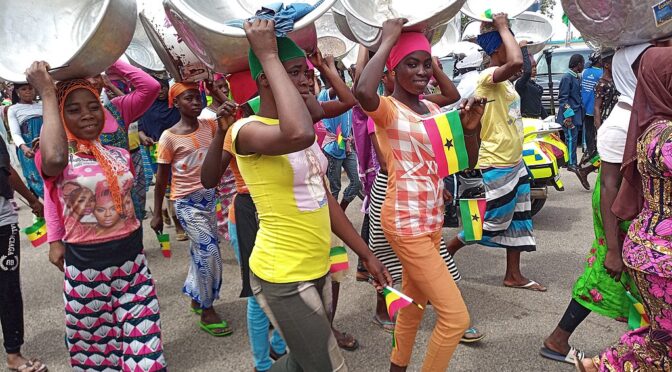The importance of collective organization and collaboration of Kayayei in Accra, Ghana
By Tetyana Samiliv
Introduction
Kayayei or Kaya Yei (singular Kaya Yoo) is a Ga term for female porter or bearer. Kayayei are usually migrant women from the north who come to Accra in hopes of earning a living and furthering their education. When immigrating to Accra, Kayayei usually settle in the Old Fadama neighborhood, an informal settlement with between 80,000 and 100,000 residents, because it offers the most affordable housing in the city. Founded by migrants from northern Ghana during the tribal Konkomba-Nanumba tribal war, Old Fadama is located on the banks of Korle Lagoon along the Odaw River, which is flowing on the west side of the city center.
Multiple local and international organizations are working to assist Kayayei and advocate for their and their children’s future, as well as training them in skills that can help them secure permanent jobs such as sewing. One of these organizations is the Old Fadama Kayayei Organization led by 26 year-old Rukaya Bawule, which supported Kayayei during the Covid-19 pandemic by educating them on the need for PPE and vaccination, and by advocating for their needs to the local government (Wiego, 2021). Fashion organizations, such as the OR Foundation, also recognize the key role Kayayei play in the second-hand fashion industry and contribute by providing industry training to Kayayei.
Analysis
Many Kayayei make their living carrying products and materials to and from two large waste and reuse sites: the world’s largest e-waste landfill known as Agbogbloshie and the largest secondhand clothing market in the world known as Kantamanto. The e-waste landfill provides a metal mining and reuse market, while the Kantamanto market is recognized as the largest circular economy reuse and upcycle center in the world. Here, sellers and fashion designers resell and reuse clothing and fabric to make new designs and reuse clothes that would otherwise go straight to the landfill (The Or Foundation, 2021). The locals call the secondhand clothing sent from the west “obroni wavu” or “the dead white man’s clothes” in Twi, the language spoken mainly by the Akan people, the largest of seventeen ethnic groups of Ghana (Besser, 2021). Kayayei perform the onerous task of carrying heavy bundles of clothing through the market, and if they are injured on the job they are usually sent back home with no compensation. Since they are working in the informal economy, they do not receive unemployment assistance, medical care is expensive, and during Covid-19, they were the last to receive assistance.
Although Kayayei like other women in the informal sector are socially, politically, and economically invisible (Kinyajui, 2014), they have been organizing to achieve better living standards and basic needs such as shelter, safety, and healthcare. The most prominent example of these organizing efforts is the Old Fadama Kayayei Association, which provided critical support for Kayayei during the heights of the Covid-19 pandemic (WIEGO, 2021). When the markets started being cleared by the police during the pandemic, and the demand for Kayayei services dropped, evictions became more frequent, and Kayayei were often stigmatized as carriers of disease, forcing them to skip meals and send their children to relatives in the north of Ghana. In the absence of government support, the Old Fadama Kayayei Association established a support network for Kayayei to share meals and child responsibilities, educated members about the importance of PPE and vaccinations, and advocated for government protection and provision of healthcare support (WIEGO, 2021), becoming an example of what (Kinyajui, 2014: p. 14) describes as a “creative response to the innate desire for survival and self-actualization”.
The networks constituted by the Kayayei constitute what Simone (2004) refers to as an ‘infrastructure,’ where people in “conjunction with activities, modes of production and institutional forms” collaborate with each another and form social networks. Relationships are incredibly important when conventional planning and infrastructure fail to support marginalized groups (Simone, 2004), and through their movements and interactions with each other and other residents of Accra, Kayayei increase the productivity of both the formal and the informal economy. Although Arnall and Kothari (2014) argue that waste is socially constructed and usually seen as unwanted matter, in the context of Accra’s Agbogbloshie and Kantamanto markets, waste becomes a potential for business. When clothes are donated in the West or discarded, this waste becomes ‘matter-out-of-place’, which is then transported to Global South countries like Ghana, thus “connecting places where people or ships have rarely been” (Arnall and Kothari, 2014).
Implications
As Kinyanjui (2014) suggests, the rational model of planning does not account for informal networks of connections and everyday transactions (see also Kamete, 2013; Nunbogu, 2018). While Kayayei are essential to the flow of goods across Accra, “contributing to the complexity of urban morphology” (Kinyanjui, 2014: p.3), they still confront gender and economic inequalities as well as “barriers created by planning ideologies and gender insensitivity” (Kinyanjui, 2014: p.2). The example of the Kayayei highlights the importance of planners to work more closely with the movements and organization of groups that are not included in traditional planning. Women around the world provide a vast majority of labor in informal economy: in sub-Saharan Africa, 74% of women work in informal employment, and in South Asia it reaches nearly 80% (Women for Women, 2020). Kayayei are the backbone of informal planning, and their collective organization serves as an example of how city planners can work with the city’s diverse residents.

A group of Kayayoo women marching at Ghana’s 2020 Independence Day Parade. Author: Quami43. Source

Fashion Revolution. Source

A discarded shirt in the market. Foreign Corresponded: Andrew Greaves (ABC News). Source
